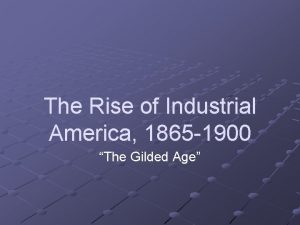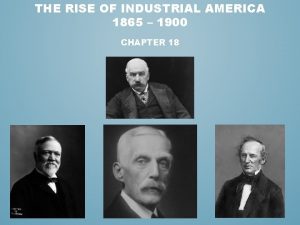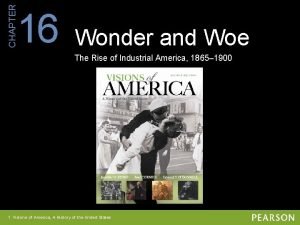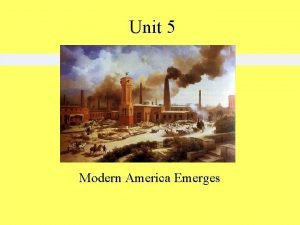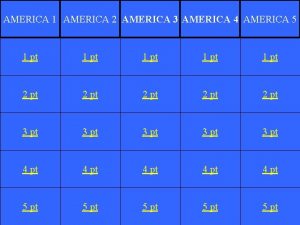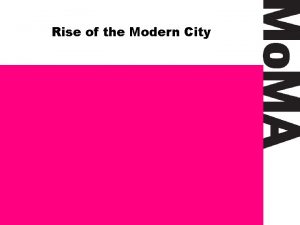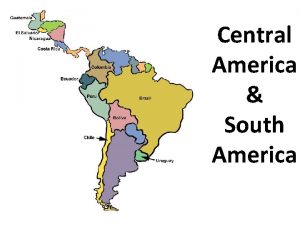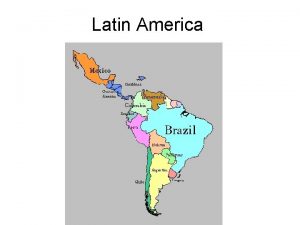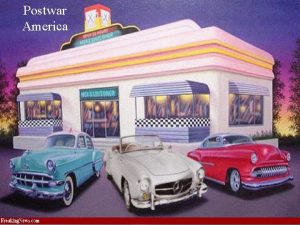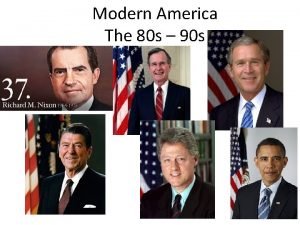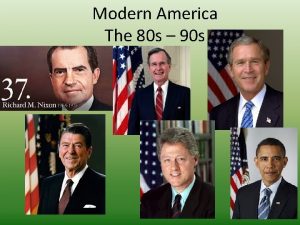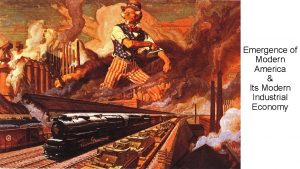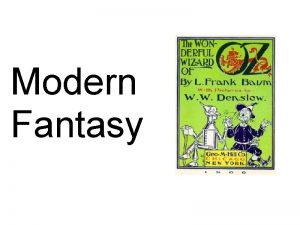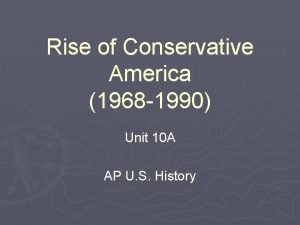Unit Two Rise of Modern America The Rise






































- Slides: 38

Unit Two: Rise of Modern America The Rise of Monopolies and The Modern American Economy

Rise of Modern America • After the Civil War Americans were looking toward the future and the rebuilding of American business, economy, and society. • The development of a modern America came about due to the growth of industry, the second industrial Revolution, urbanization, and mass immigration into America during and after the Civil War. • The growth of industry led America to the founding of a modern day economy and the beginning of the society we have today.

The First Industrial Revolution • American industry first started as small family run businesses called Cottage Industry. • In the Cottage Industry or Putting out system introduced to America from England by Samuel Slaughter twine was spun in a factory which was then put out to contracted families where the women spun the twin into cloth. • This was the growth of the early textile industry in America, but was also used for other industries as well.

Factory System • Due to inventions such as the spinning jenny and the steam engine all processes of production where combined into one building called the Factory System. • The Lowell/Waltham system hired young (16 -24) single women who worked in factories (plant) for 80 hours a week (six days: 13 hours a day). • The mill girls lived in company owned apartments called boarding houses where they were supervised by older women “mothers” and where subject to strict rules.

Change in Industry • The industries developed during the first Industrial Revolution were either sole proprietorship (one owner) or partnerships (more than one partners) which limited the amount of capital that could be raised, limited the ability to expand, and also investors risked incurring debt from the business. • During most of the first Industrial Revolution few companies became corporations, but during and after the Civil War most companies changed to be able to create larger (mega) companies. (due to state corporation laws) • With the expansion of the railroad system in America, which needed large amounts of capital to fund it and ready capital from gold strikes and banks, companies changed to corporations.

Why America? • During and after the Civil War American industry and the economy grew at a faster rate than any European country. • The reason America was able grow at such a fast rate was do in part to vast natural resources (land, timber, mineral deposits (bituminous/soft and anthracite/hard coal, oil, and natural gas), large labor base (immigrants), large capital base (many banks willing to lend money), government policies (laissez faire-hands off and free enterprise), greater transportation (growth of railroads), and new inventions (Second Industrial Revolution) • The five big products and services that developed modern America were railroads, steel, oil, electricity, and banks.

Government “Plays” a Role • During the late 1800 s and early 1900 s the government passed laws and polices that were pro-business to encourage the growth of business. • The Federal government mostly followed a laissez-fare or hands off model when dealing with state and business affairs, with little regulations as possible. • The Federal government operated under the free enterprise system and Capitalism (Adam Smith’s Wealth of Nations)

Government “Plays” a Role • The government passed the National Bank Act of 1863 and Contract Labor Law of 1864. • The government passed a series of high protective tariffs to aid American business known as the Morrill (1861), Mc. Kinley (1890), Wilson. Gorman (1894), and Dingley (1897). • The U. S. Supreme Court also made many rulings protecting corporations during this time by giving them the same equal rights of a person protected by the U. S. Constitution (14 th amendment) and allowing states to regulate them instead of the Federal Government. ( e. g. Slaughter-House Cases (1873 ), Wabash v. Illinois (1886), and Smyth v. Ames (1898))

Rise of the Modern Business • The growth of the modern companies came from the growth of corporations during and after the Civil War. • A corporation is a company that is chartered by a state with the ability to sell shares of stock (percent of company ownership) to stockholders, which they may receive dividends from profits made or sell the stocks for profit when the companies value increases. (shares in a company also give voting rights in a company) • The shares or stocks in a company are traded at a special market called a stock market. (The New York Stock Exchange 1863)To give finical information about stocks the Dow Jones and Company (Henry Dow and Edward Jones) was founded in 1882 also Wall Street Journal in 1889.

Rise of the Modern Business • A corporation is run by a board of directors with a chairman called a CEO (chief executive officer). • A corporation allowed for tremendous growth by allowing for many investors (capital-money) and limited liability (company goes bankrupt, investor only loses money invested; also protected from lawsuits). • The larger scale of business (corporation) was due to larger pools of capital, wider geographic area, boarder range of operations, revised role of ownership, and new methods of management; which only led to larger more complex company organizations.

Rise of the Modern Business • With the rise of larger companies came the idea of combinations (were companies are merged together either through mergers or hostile takeovers) to gain more control over the sell of a product or service. • Combinations developed into two basic ways: – Horizontal Integration is when a company owns all competitors who sell the same product or do the same service. (Standard Oil) – Vertical Integration is when a company owns all the factors that go in the production of a good or service. (U. S. Steel)

Vertical and Horizontal Combinations

Rise of the Modern Business • The rise of combinations led to the development of monopolies (sole ability to sell a good or service). • Monopolies developed in many different ways such as: – Oligopoly - when a few companies dominate a market and affect each other. – Cartel/Pools - when companies agree to work together to fix prices. (mostly used by railroads) – Trust system – when stockholders with majority voting shares in different companies give their stocks to a Trustee for Trust certificates (acquire a large monopoly without spending a lot of money). – Holding Companies – when a corporation is founded for the propose of owning stocks in other companies. (replaced Trusts)

Rise of the Modern Business • The development of monopolies in America effected the economy and businesses for the good and the bad: – Pros – People who favored monopolies stated that they stabilized the marketplace and could sell products at lower prices due to mass of production – Cons – People who dislike or distrusted monopolies stated that they stifled competition (small business) and hurt consumers form the ability to control prices.

Pro and Con Monopolies PRO CON

Change in Business Techniques and Policies • Americans during this time also had to change the way their businesses were run to be able to efficiently conduct business on such a large scale. • The ideas of “scientific” management were applied to businesses by Fredrick Taylor with his system called Taylorism, which through the study of time, motion, and techniques developed a plan for subdividing work and standardization of practices to increase productivity and efficiency. • Taylorism also led to division of labor (separation of the production of product into many steps) and specialization (each worker does a repetitive specialized task in production).

Change in Business Techniques and Policies • The techniques of mass production also changed due to economics of scale (as production of an item increases the cost to make it decreases). • To run the large corporations tycoons hired a new group of college educated operatives called professional managers. • Corporate finance also changed with the introduction of cost-accounting procedures (cost of running a business) through better evaluations of how to control fixed costs (overhead) and lower operating costs (wages and etc).

Rise of the Captains of Industry • As corporations grew they led to the rise of Captains of Industry or tycoons (Business owners who owned multiple industries amassing a large personal fortune, but also contributing to the common good of society). • When the combinations (monopolies) became the major form of business organization, captains of industry became referred to as Robber Barons (businessmen through political influence and unscrupulous business practices to amass large personal fortunes and power). • The board game Monopoly was developed in 1903 by Elizabeth (Lizzie) Magie, showed how monopolies were created and how they “hurt” everyone else. (the game went through many changes, first called Landlord’s Game)

Railroads lead the Way • The growth of the large corporation in America first developed in the Railroad industry with a massive increase in track mileage (30, 000 in 1865 to 200, 000 in 1900) which also stimulated other industries such as steel, coal, wood, iron, and etc. , also increased the ease of transportation of bulky and numerous products opening up new markets for new consumer manufacturers. (all growing larger each year) • Many improvements in the railroad industry aided its growth and other industries such as standard gauge track, specialized cars, George Pullman’s sleeping cars, George Westinghouse’s air brakes, Granville Woods’ moving train telegraph, Eli H. Janney’s car couplers and time zones.

Railroads lead the Way • Many different businessmen were competing to monopolize the rail system to make profit by consolidations, rebates (discounts or money back) to customers, insider trading, pools, or bribing government officials. • The first major tycoon in America was Cornelius Vanderbilt who consolidated the railways from New York to Chicago forming the New York Central (1870). (controlled over 4, 500 miles of track with a net worth of US$105 million in 1877160 billion today) • Other major railroad tycoons were J. Edger Thomson (Pennsylvania Railroad), Jay Gould, James J. Hill (Great Northern), and Henry Flagler (Florida East Coast Railway)

Cornelius Vanderbilt

The Pinnacle Robber Barrons • The greatest of all Robber Barrons was Jay Gould who got his start on railroads by embezzling (stealing from within a company) stocks from the Erie, Kansas Pacific, and the Union Pacific Railroads. • Gould among others would grossly over-inflate the worth of their stock and sell them for huge profits called stock watering. • Jay Gould and “Diamond or Jubilee” Jim Fisk in 1869 tried to corner the gold market by driving prices really and selling them off caused the Panic of Black Friday and a slight recession.

Railroads lead to Corruptions • The Transcontinental Railroad was one of the greatest accomplishments in American history and one of the greatest corruption scandals known as the Credit Mobilier Scandal. • The Transcontinental Railroad started when Theodore Dehone Judah planned out the route and got Congress to pass the first Pacific Railway Act of 1862. (died the next year) • The owners of the Central Pacific (Leland Stanford, Collis P. Huntington, Charles Crocker, and Mark Hopkins) known as the “Big Four” built the railroad from California with their engineer Charles Crocker.

Railroads lead to Corruptions • The owner of the Union Pacific Thomas Durant with his engineer General Grenville M. Dodge built it from Omaha. • As both railroads were built they used out of the way routes to collect more land money, but the board of directors of the Union Pacific organized a construction company called Credit Mobilier to funnel profits into their pockets by overcharging and giving out stocks. • After Congress investigated the matter many members of Congress, businessmen, and even Grant’s Vice President Schuyler Colfax were discredited. (no one went to jail).

Other Transcontinental Rails • To increase trade across the nation, increase their personal wealth, and gain more land four other Transcontinental Railroads were built before 1900 – The Northern Pacific stretched from Lake Superior to Puget Sound. – The Atchison, Topeka, and Santa Fe stretched through the Southwest. – The Southern Pacific went from New Orleans to San Francisco. – The Great Northern ran from Duluth to Seattle and was built by James. Hill.

Steel Industry • The Steel industry began with the development of the Bessemer Process (blasting air through molten iron) developed by Henry Bessemer (English) and William Kelly (American) in the 1850 s. • The first major steel plants developed in Pittsburgh, Penn. receiving large deposits of iron ore from the rich Mesabi Range. • The major steel magnate that developed in America was Andrew Carnegie with his company Carnegie Steel (later U. S. Steel). (By 1900 he controlled most of the steel output in America with a net worth of 475 million – 280 billion today)

Steel Industry • Carnegie built his empire through vertical integration and also by bringing in lucrative partners such as Henry Frick (cornered the coke industry). • During late 1800 s the South became a major producer of steel with the growth of Birmingham, Alabama, due to the large deposits of bituminous coal, iron ore, and limestone. • Early founders of the steel industry in Birmingham were Daniel Pratt (Pratt Coal and Coke Company), James Sloss (Sloss Furnaces), and Truman Aldrich (Cahaba Coal Company). • The Steel industry made all things possible from skyscrapers to railroads.

Andrew Carnegie

Oil Industry • The oil industry in America started in the 1850 s when Samuel Kier invented a way to refine crude oil into Kerosene. (replaced whale oil for lamps) • The first oil well in America to drill for “rock oil” was a joint venture by George Bissell and Edwin Drake which struck oil in Titusville, Penn. In 1859. • The first oil wells were very wasteful in drilling, pumping, storing, and allowed holes to be ruined. • At the beginning of oil refining only kerosene was important, a product of oil refining, gasoline, was simply thrown away as waste.

Oil Industry • Oil terminology: – Derrick – drill platform; drilling rig – Pump Jack – oil pumping system – Gusher – an oil well that yields a large amount. – Wildcatter- a person who drills for oil in undiscovered areas. – Royalty – money paid to a land owner for oil lease.

Standard Oil • The person who cornered the oil industry in the late 1800 s was John D. Rockefeller with his main partner Henry Flagler by forming a horizontal monopoly of oil refineries called Standard Oil. • Rockefeller used “any means necessary” business practices to form Standard Oil into a massive vertical monopoly controlling 95 percent of the oil refining in America by 1879. (Rockefeller’s net worth was in today’s money $663. 4 billion

John D. Rockefeller

Banking Industry • Just like other industries during the late 1800 s the banking industry went through many changes developing into a modern day banking system due to the need for loans and capital to fuel massive growth of corporations. • The banking industry was transformed by the development of finance capitalism, where bankers used the large sums of money at their disposal to acquire stocks, control, and/or ownership over other corporations. • The most notable early banking houses where controlled by J. P. Morgan, August Belmont, and George Peabody.

Banking Industry • The person who cornered the banking industry and thus later played a large part in control over the whole national economy was John Pierpont (J. P. ) Morgan. • J. P. Morgan used his banks to be able to purchase failing companies, “remorganize” them, consolidate them with other businesses, and placed his own men on rival companies’ boards of directors called interlocking directorates. (Morgan did not like competition because he wanted a controllable economy) • J. P. Morgan purchased Carnegie’s Steel industry consolidating it and formed U. S. Steel in 1901 which was the first billion dollar corporation in the world.

J. P Morgan

Other Industries • James B. Drake founded the American Tobacco Company creating a monopoly through the use of the Bonsack rolling machine (“ready rolls”) • Charles Pillsbury invented a purifier that made bread flour uniform and used a rolling production to mass produce flour. (sold out later to General Mills also created in the same time) • Henry J. Heinz founded the H. J. Heinz company for the mass production of ketchup (57 varieties) • Joseph Campbell founded Campbell Soup Company mass producing canned soups and etc. • William C. Procter and James Gamble founded the company P&G mass producing Ivory soap that was 99 -100% pure (It Floats)

Other Industries • Frick and Charles Schwab formed Bethlehem Steel as the second largest steel company. • Henry O. Havemeyer started the American Sugar refining company having a monopoly on sugar. • Philip D. Amour and Gustavus Swift monopolized the meat packing industry. • John Pemberton invented Coca Cola which was purchased by Asa Candler and made into the Coca Cola Company. (first main two ingredients Cocaine and Kola nut) • The Du Point family founded the Du Point company which started with smokeless gunpowder and expanded into the leading manufacturer of the early chemical industry.

Family of Trusts What point are the artists making about Trusts? They are controlling all aspect of American life, and only helping themselves become wealthy. Is it a completely true evaluation?
 Rise and rise until lambs become lions
Rise and rise until lambs become lions Tricky dicky richard nixon
Tricky dicky richard nixon Little lambs academy
Little lambs academy Rise and rise again until lambs become lions origin
Rise and rise again until lambs become lions origin The rise of industrial america 1865-1900
The rise of industrial america 1865-1900 The rise of industrial america 1865-1900
The rise of industrial america 1865-1900 The rise of industrial america chapter 16
The rise of industrial america chapter 16 We can do a rap of the map of the us
We can do a rap of the map of the us Asia europe north america
Asia europe north america Repetition in let america be america again
Repetition in let america be america again Why called latin america
Why called latin america Eu amo a américa e a américa me ama
Eu amo a américa e a américa me ama Modern america emerges
Modern america emerges Unit 6 review questions
Unit 6 review questions Hình ảnh bộ gõ cơ thể búng tay
Hình ảnh bộ gõ cơ thể búng tay Frameset trong html5
Frameset trong html5 Bổ thể
Bổ thể Tỉ lệ cơ thể trẻ em
Tỉ lệ cơ thể trẻ em Gấu đi như thế nào
Gấu đi như thế nào Tư thế worm breton
Tư thế worm breton Hát lên người ơi
Hát lên người ơi Các môn thể thao bắt đầu bằng từ đua
Các môn thể thao bắt đầu bằng từ đua Thế nào là hệ số cao nhất
Thế nào là hệ số cao nhất Các châu lục và đại dương trên thế giới
Các châu lục và đại dương trên thế giới Công của trọng lực
Công của trọng lực Trời xanh đây là của chúng ta thể thơ
Trời xanh đây là của chúng ta thể thơ Cách giải mật thư tọa độ
Cách giải mật thư tọa độ Làm thế nào để 102-1=99
Làm thế nào để 102-1=99 độ dài liên kết
độ dài liên kết Các châu lục và đại dương trên thế giới
Các châu lục và đại dương trên thế giới Thể thơ truyền thống
Thể thơ truyền thống Quá trình desamine hóa có thể tạo ra
Quá trình desamine hóa có thể tạo ra Một số thể thơ truyền thống
Một số thể thơ truyền thống Bàn tay mà dây bẩn
Bàn tay mà dây bẩn Vẽ hình chiếu vuông góc của vật thể sau
Vẽ hình chiếu vuông góc của vật thể sau Biện pháp chống mỏi cơ
Biện pháp chống mỏi cơ đặc điểm cơ thể của người tối cổ
đặc điểm cơ thể của người tối cổ Ví dụ về giọng cùng tên
Ví dụ về giọng cùng tên Vẽ hình chiếu đứng bằng cạnh của vật thể
Vẽ hình chiếu đứng bằng cạnh của vật thể




